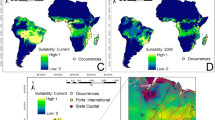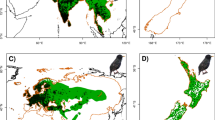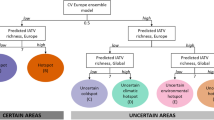Abstract
Prediction of the geographic distribution of an exotic species in a new environment is an important element of risk assessment as it provides an assessment of the spatial scale of potential impacts and the range of ecosystems affected by the establishment of an exotic species. For a more complete risk assessment, however, information on how abundant the species is likely to become at specific locations within the predicted geographic distribution would allow a more detailed analysis of potential environmental and economic impacts. In this study an improved species distribution model for Epiphyas postvittana, an Australian leafroller, is developed and used to test for an abundance–suitability relationship based on survey data on its relative abundance in coastal California where it has become established as an exotic species. To better assess the current status of this exotic leafroller as a quarantine pest in California, the potential geographic distribution and its relative abundance are predicted for the conterminous United States. These analyses predict that E. postvittana would primarily be limited to the Pacific coastline with small pockets of less suitable environment supporting lower relative abundance on the east coast and in the southwest. This study also highlights the potential value of the core distribution from the CLIMEX species distribution model as a more informative metric of environmental suitability with respect to relative abundance, based on surveys of larval populations of E. postvittana at 30 different locations in coastal California.




Similar content being viewed by others
Data accessibility
The datasets generated during and/or analysed during the current study are available from the corresponding author on reasonable request.
References
Acevedo P, Ferreres J, Escudero MA, Jimenez J, Boadella M, Marco J (2017) Population dynamics affect the capacity of species distribution models to predict species abundance on a local scale. Diversity Distrib 23:1008–1017
Avila GA, Davidson M, van Helden M, Fagan L (2019) The potential distribution of the Russian wheat aphid (Diuraphis noxia): an updated distribution model including irrigation improves model fit for predicting potential spread. Bull Entomol Res 109:90–101
Bradley BA, Allen JM, O’Neill MW, Wallace RD, Bargeron CT, Richburg JA et al (2018) Invasive species risk assessments need more consistent spatial abundance data. Ecosphere 9:e02302
Bradshaw CJA, Leroy B, Bellard C, Roiz D, Albert C, Fournier A et al (2016) Massive yet grossly underestimated global costs of invasive insects. Nat Commun 7:12986
Brockerhoff EG, Liebhold AM (2017) Ecology of forest insect invasions. Biol Invasions 19:3141–3159
Brockerhoff EG, Suckling DM, Ecroyd CE, Wagstaff SJ, Raabe MC, Dowell RV et al (2011) Worldwide host plants of the highly polyphagous, invasive Epiphyas postvittana (Lepidoptera: Tortricidae). J Econ Entomol 104:1514–1524
Brown JH (1984) On the relationship between abundance and distribution of species. Am Nat 124:255–279
Brown JW, Epstein ME, Gilligan TM, Passoa SC, Powell JA (2010) Biology, identification, and history of the light brown apple moth, Epiphyas postvittana (Walker) (Lepidoptera: Tortricidae: Archipini) in California: an example of the importance of local faunal surveys to document the establishment of exotic insects. Am Entomol 56:34–43
Bürgi LP, Mills NJ (2014) Lack of enemy release for an invasive leafroller in California: temporal patterns and influence of host plant origin. Biol Invasions 16:1021–1034
Bürgi LP, Roltsch WJ, Mills NJ (2015) Allee effects and population regulation: a test for biotic resistance against an invasive leafroller by resident parasitoids. Popul Ecol 57:215–225
Cade BS, Noon BR (2003) A gentle introduction to quantile regression for ecologists. Frontiers Ecol Environ 1:412–420
Colautti RI, Lau JA (2015) Contemporary evolution during invasion: evidence for differentiation, natural selection, and local adaptation. Mol Ecol 24:1999–2017
Cross T, Finn JT, Bradley BA (2017) Frequency of invasive plant occurrence is not a suitable proxy for abundance in the Northeast United States. Ecosphere 8:e01800
Crystal-Ornelas R, Lockwood JL (2020) The ‘known unknowns’ of invasive species impact measurement. Biol Invasions 22:1513–1525
Cunningham N (2007) Lightbrown apple moth (LBAM) culture Epiphyas postvittana. South Australian Research and Development Institute (S.A.R.D.I.), Australia
da Silva RS, Kumar L, Shabani F, Picanço MC (2018) An analysis of sensitivity of CLIMEX parameters in mapping species potential distribution and the broad-scale changes observed with minor variations in parameters values: an investigation using open-field Solanum lycopersicum and Neoleucinodes elegantalis as an example. Theor Appl Climatol 132:135–144
Dallas TA, Hastings A (2018) Habitat suitability estimated by niche models is largely unrelated to species abundance. Global Ecol Biogeogr 2018:1–9
Dallas TA, Decker RR, Hastings A (2017) Species are not most abundant in the center of their geographic range or climatic niche. Ecol Lett 20:1526–1533
Dallas TA, Santini L, Decker R, Hastings A (2020) Weighing the evidence for the abundance-center hypothesis. Biodivers Inform 15:81–91
Danthanarayana W (1975) The bionomics, distribution and host range of the light brown apple moth, Epiphyas postvittana (Walk.) (Tortricidae). Aust J Zool 23:419–437
Danthanarayana W (1983) Population ecology of the light brown apple moth, Epiphyas postvittana (Lepidoptera: Tortricidae). J Anim Ecol 52:1–33
Danthanarayana W, Gu H, Ashley S (1995) Population growth potential of Epiphyas postvittana, the lightbrown apple moth (Lepidoptera: Tortricidae) in relation to diet, temperature and climate. Aust J Zool 43:381–394
Drake JM, Richards RL (2018) Estimating environmental suitability. Ecosphere 9:e02373
Early R, Bradley BA, Dukes JS, Lawler JJ, Olden JD, Blumenthal DM et al (2016) Global threats from invasive alien species in the twenty-first century and national response capacities. Nat Commun 7:12485
Elith J (2017) Predicting distributions of invasive species. In: Robinson AP, Walshe T, Burgman MA, Nunn M (eds) Invasive species: risk assessment and management. Cambridge University Press, Cambridge, pp 93–129
Filz KJ, Schmitt T, Engler JO (2013) How fine is fine-scale? Questioning the use of fine-scale bioclimatic data in species distribution models used for forecasting abundance patterns in butterflies. Eur J Entomol 110:311–317
Fowler G, Garrett L, Neeley A, Margarey R, Borchert D, Spears B (2009) Economic analysis: risk to US apple, grape, orange and pear production from the light brown apple moth, Epiphyas postvittana (Walker). USDA-APHIS-PPQ-CPHST-PERAL, p 28
Franklin J (2010) Mapping species distributions: spatial inference and prediction. Cambridge University Press, Cambridge
Franklin J (2013) Species distribution models in conservation biogeography: developments and challenges. Divers Distrib 19:1217–1223
Gallien L, Münkemüller T, Albert CH, Boulangeat I, Thuiller W (2010) Predicting potential distributions of invasive species: Where to go from here? Divers Distrib 16:331–342
Geier PW, Briese DT (1979) The light-brown apple moth, Epiphyas postvittana (Walker): 3. differences in susceptibility to a nuclear polyhedrosis virus. Aust J Ecol 4:187–194
Geier PW, Springett BP (1976) Population characteristics of Australian leafrollers infesting orchards (Epiphyas spp., Lepidoptera). Aust J Ecol 1:129–144
Gilligan TM, Epstein ME (2009) LBAM ID: tools for diagnosing light brown apple moth and related western US leafrollers (Tortricidae: Archipini) [CD-ROM]. USDA–APHIS
Grafton-Cardwell EE, Stelinski LL, Stansly PA (2013) Biology and management of Asian citrus psyllid, vector of the huanglongbing pathogens. Annu Rev Entomol 58:413–432
Gutierrez AP, Mills NJ, Ponti L (2010) Limits to the potential distribution of light brown apple moth in Arizona-California based on climate suitability and host plant availability. Biol Invas 12:3319–3331
He S, Worner SP, Ikeda T (2012) Modeling the potential global distribution of light brown apple moth Epiphyas postvittana (Lepidoptera: Tortricidae) using CLIMEX. J Asia Pac Entomol 15:479–485
Hendry AP (2016) Eco-evolutionary dynamics. Princeton University Press, Princeton
Herms DA, McCullough DG (2014) Emerald ash borer invasion of North America: history, biology, ecology, impacts, and management. Annu Rev Entomol 59:13–30
Hill MP, Gallardo B, Terblanche JS (2017) A global assessment of climatic niche shifts and human influence in insect invasions. Global Ecol Biogeogr 26:679–689
Hogg BN, Wang X-G, Mills NJ, Daane KM (2014) Resident spiders as predators of the recently introduced light brown apple moth, Epiphyas postvittana. Entomol Exp Appl 151:65–74
Hogg BN, Mills NJ, Daane KM (2017) Temporal patterns in the abundance and species composition of spiders on host plants of the invasive moth Epiphyas postvittana (Lepidoptera: Tortricidae). Environ Entomol 46:502–510
Ireland KB, van Klinken R, Cook DC, Logan D, Jamieson L, Tyson JL et al (2020) Plant pest impact metric system (PPIMS): framework and guidelines for a common set of metrics to classify and prioritise plant pests. Crop Prot 128:105003
Jiménez-Valverde A, Diniz F, de Azevedo EB, Borges PAV (2009) Species distribution models do not account for abundance: the case of arthropods on Terceira Island. Ann Zool Fennici 46:451–464
Jiménez-Valverde A, Peterson A, Soberón J, Overton JM, Aragon P, Lobo JM (2011) Use of niche models in invasive species risk assessments. Biol Invasions 13:2785–2797
Kenis M, Auger-Rozenberg M-A, Roques A, Timms L, Péré C, Cock MJW et al (2009) Ecological effects of invasive alien insects. Biol Invasions 11:21–45
Koenker R (2018) Quantreg: quantile regression. R package version 5.36. Retrieved from http://CRAN.R-project.org/package=quantreg
Koenker R, Machado JAF (1999) Goodness of fit and related inference processes for quantile regression. J Am Stat Assoc 94:1296–1310
Kriticos DJ, Webber BL, Leriche A, Ota N, Bathols J, Macadam I et al (2012) CliMond: global high resolution historical and future scenario climate surfaces for bioclimatic modelling. Methods Ecol Evol 3:53–64
Kriticos DJ, Maywald GF, Yonow T, Zurcher EJ, Herrmann NI, Sutherst RW (2015) CLIMEX version 4: exploring the effects of climate on plants, animals and diseases. CSIRO, Canberra, p 184
Lantschner MV, de la Vega G, Corley JC (2018) Predicting the distribution of harmful species and their natural enemies in agricultural, livestock and forestry systems: an overview. Int J Pest Manag. https://doi.org/10.1080/09670874.2018.1533664
Lawson BE, Day MD, Bowen M, van Klinken RD, Zalucki MP (2010) The effect of data sources and quality on the predictive capacity of CLIMEX models: An assessment of Teleonemia scrupulosa and Octotoma scabripennis for the biocontrol of Lantana camara in Australia. Biol Control 52:68–76
Le Maitre DC, Thuiller W, Schonegevel L (2008) Developing an approach to defining the potential distributions of invasive plant species: a case study of Hakea species in South Africa. Global Ecol Biogeogr 17:569–584
Leskey TC, Nielsen AL (2018) Impact of the invasive brown marmorated stink bug in North America and Europe: history, biology, ecology, and management. Annu Rev Entomol 63:599–618
Liu C, Wolter C, Xian W, Jeschke (2020) Species distribution models have limited spatial transferability for invasive species. Ecol Lett 23:1682–1692
Lozier JD, Mills NJ (2011) Predicting the potential invasive range of light brown apple moth (Epiphyas postvittana) using biologically informed and correlative species distribution models. Biol Invasions 13:2409–2421
McLachlan RA (1970) Grape pest control in Queensland. Qld Agric J 96:231–235
Oliver TH, Gillings S, Girardello M, Rapacciuolo G, Brereton TM, Siriwardena GM et al (2012) Population density, but not stability can be predicted from species distribution models. J Appl Ecol 49:581–590
Parker IM, Simberloff D, Lonsdale WM, Goodell K, Wonham M, Kareiva PM et al (1999) Impact: toward a framework for understanding the ecological effects of invaders. Biol Invasions 1:3–19
Paull C, Austin AD (2006) The hymenopteran parasitoids of light brown apple moth, Epiphyas postvittana (Walker) (Lepidoptera: Tortricidae), in Australia. Aust J Entomol 45:42–56
Peterson ML, Doak DF, Morris WF (2019) Incorporating local adaptation into forecasts of species’ distribution and abundance under climate change. Glob Change Biol 25:775–793
QGIS Development Team (2018) QGIS geographic information system. Open Source Geospatial Foundation Project. http://qgis.osgeo.org
Roy HE, Rabitsch W, Scalera R, Stewart A, Gallardo B, Genovesi P et al (2018) Developing a framework of minimum standards for the risk assessment of alien species. J Appl Ecol 55:526–538
Sagarin RD, Gaines SD (2002) The “abundant centre” distribution: to what extent is it a biogeographical rule? Ecol Lett 5:137–147
Seebens H, Blackburn TM, Dyer EE, Genovesi P, Hulme PE, Jeschke JM et al (2017) No saturation in the accumulation of alien species worldwide. Nat Commun 8:14435
Seebens H, Blackburn TM, Dyer EE, Genovesi P, Hulme PE, Jeschke JM et al (2018) Global rise in emerging alien species results from increased accessibility of new source pools. Proc Natl Acad Sci USA 115:E2264–E2273
Shabani F, Kumar L (2015) Should species distribution models use only native or exotic records of existence or both? Ecol Inform 29:57–65
Suckling DM, Brockerhoff EG (2010) Invasion biology, ecology, and management of the light brown apple moth (Tortricidae). Annu Rev Entomol 55:285–306
Suckling DM, Burnip GM, Walker JTS, McLaren GF, Shaw PW, McLaren GF et al (1998) Abundance of leafrollers and their parasitoids on selected host plants in New Zealand. NZ J Crop Hortic Sci 26:193–203
Suckling DM, Stringer LD, Baird DB, Butler RC, Sullivan TES, Lance DR et al (2014) Light brown apple moth (Epiphyas postvittana) (Lepidoptera: Tortricidae) colonization of California. Biol Invasions 16:1851–1863
Sutherst RW, Maywald GF, Yonow T, Stevens PM (1999) CLIMEX. Predicting the effects of climate on plants and animals. User guide. CSIRO Publishing, Melbourne, Australia
Vanderhoeven S, Branquart E, Casaer J, D’hondt B, Hulme PE, Shwartz A et al (2017) Beyond protocols: improving the reliability of expert-based risk analysis underpinning invasive species policies. Biol Invasions 19:2507–2517
VanDerWal J, Shoo LP, Johnson CN, Williams SE (2009) Abundance and the environmental niche: Environmental suitability estimated from niche models predicts the upper limit of local abundance. Am Nat 174:282–291
van Klinken RD, Lawson BE, Zalucki MP (2009) Predicting invasions in Australia by a Neotropical shrub under climate change: the challenge of novel climates and parameter estimation. Global Ecol Biogeogr 18:688–700
Warren DL, Matzke NJ, Iglesias TL (2020) Evaluating presence-only species distribution models with discrimination accuracy is uninformative for many applications. J Biogeogr 47:167–180
Weber MM, Stevens RD, Diniz-Filho JAF, Grelle CEV (2017) Is there a correlation between abundance and environmental suitability derived from ecological niche modelling? A meta-analysis. Ecography 40:817–828
Woods B, McInnis D, Steiner E, Soopaya A, Lindsey J, Lacey I et al (2016) Developing field cage tests to measure mating competitiveness of sterile light brown apple moths (Lepidoptera: Tortricidae) in Western Australia. Florida Entomol 99:138–145
Yates KL, Bouchet PJ, Caley MJ, Mengersen K, Randin CF, Parnell S et al (2018) Outstanding challenges in the transferability of ecological models. Trends Ecol Evol 33:790–802
Yonow T, Kriticos DJ, Ota N, Van Den Berg J, Hutchison WD (2017) The potential global distribution of Chilo partellus, including consideration of irrigation and cropping patterns. J Pest Sci 90:459–477
Acknowledgements
This research was supported by the United States Department of Agriculture Animal Plant Health Inspection Service through cooperative Agreement Nos. 16-8130-0651-CA and 17-8130-0651-CA.
Author information
Authors and Affiliations
Corresponding author
Ethics declarations
Conflicts of interest
The author declares no conflict of interest.
Additional information
Publisher's Note
Springer Nature remains neutral with regard to jurisdictional claims in published maps and institutional affiliations.
Rights and permissions
About this article
Cite this article
Mills, N.J. Abundance–suitability relationships for invasive species: Epiphyas postvittana as a case study. Biol Invasions 23, 2205–2220 (2021). https://doi.org/10.1007/s10530-021-02500-z
Received:
Accepted:
Published:
Issue Date:
DOI: https://doi.org/10.1007/s10530-021-02500-z




